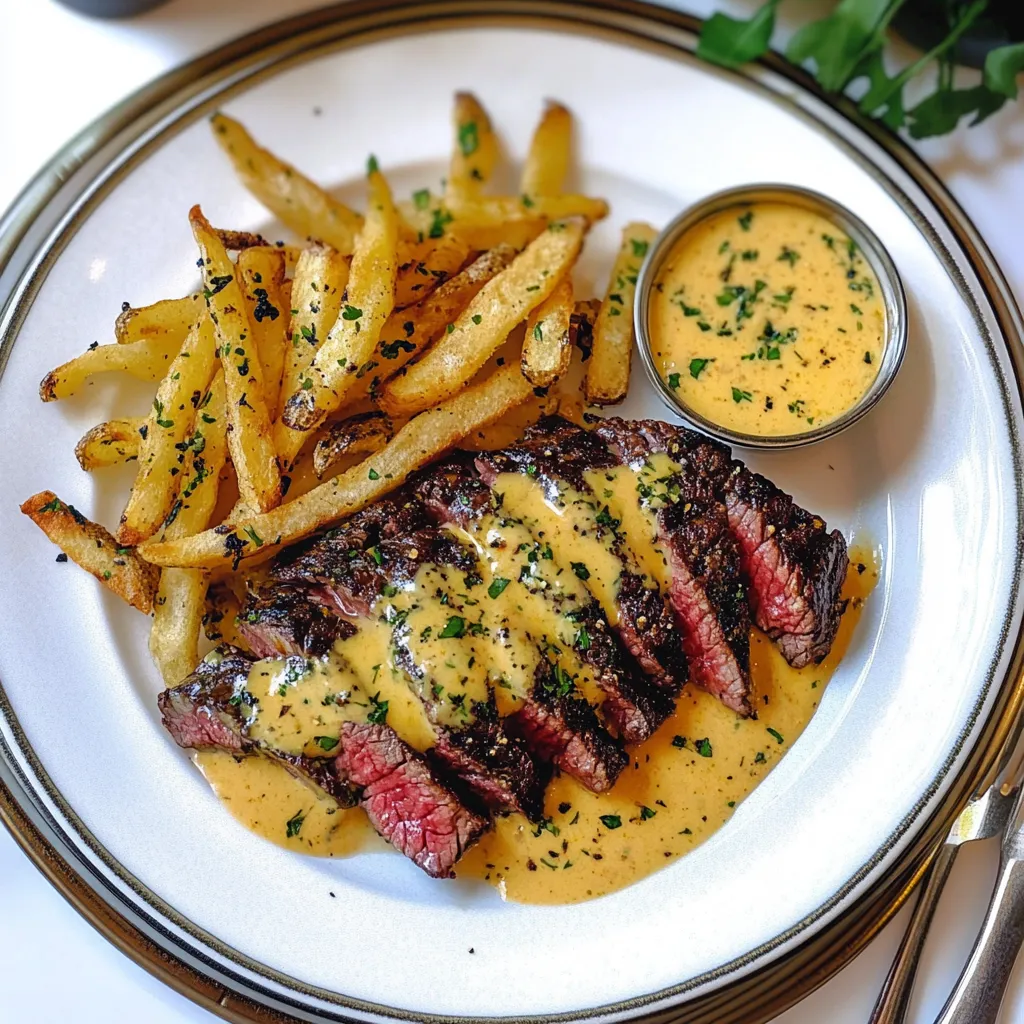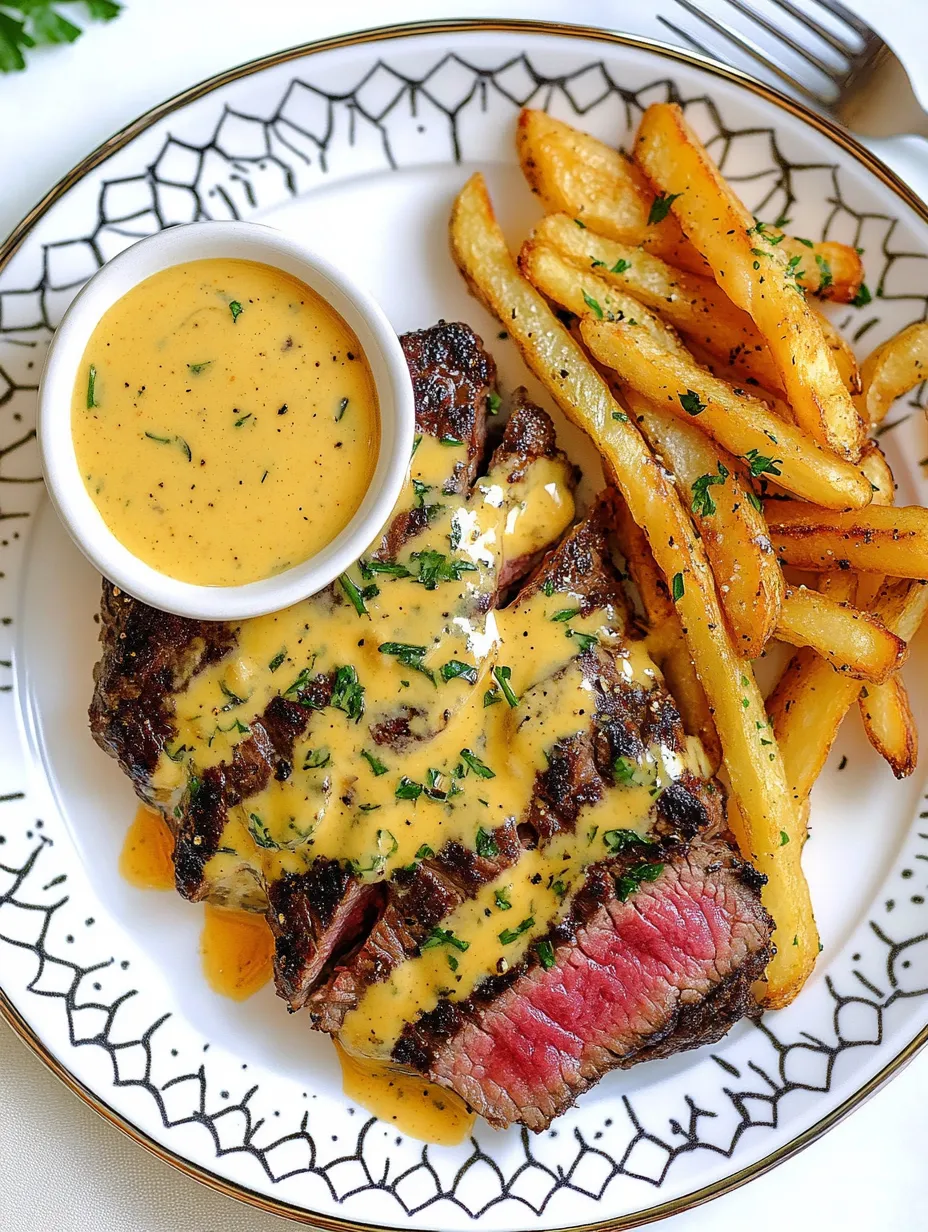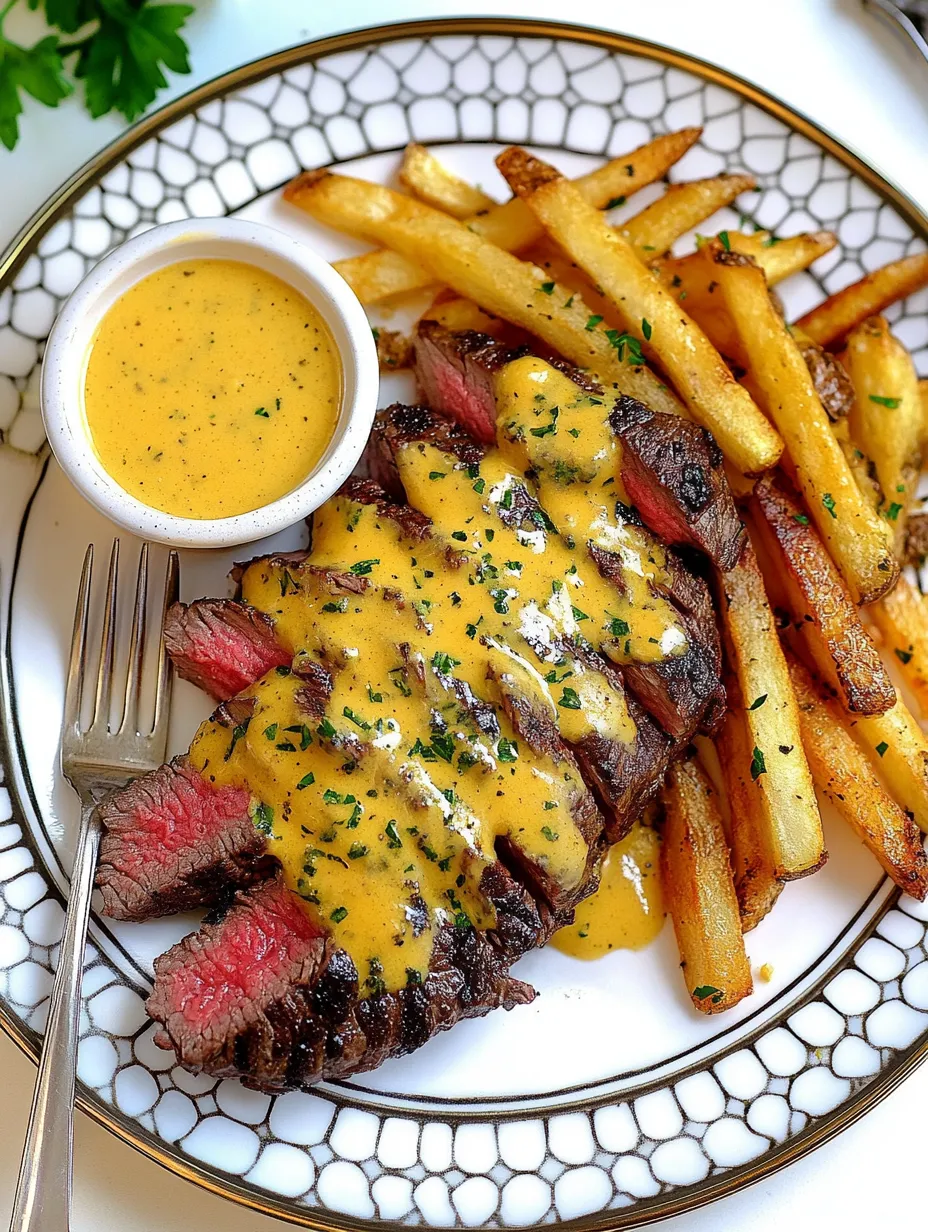 Pin it
Pin it
Steak frites elevates the humble pairing of steak and potatoes into something truly magnificent. This quintessential French bistro dish combines perfectly cooked ribeye with impossibly crispy fries, all crowned with a silky béarnaise sauce that transforms each bite into a luxurious experience. While seemingly simple, this dish represents the beautiful marriage of technique and quality ingredients that defines French cuisine at its most approachable and satisfying.
Bistro Classic
- French Tradition: Experience authentic bistro dining without leaving your kitchen
- Textural Paradise: Crispy fries, tender steak, and silky sauce create perfect balance
- Hospitality Showstopper: Impress guests with restaurant techniques made accessible
I first encountered proper steak frites during a memorable trip to Paris, where I stumbled into a tiny neighborhood bistro on a rainy afternoon. The waiter didn't speak English, and my French was embarrassingly limited, so I simply pointed to what everyone else was enjoying. What arrived was a revelation—steak cooked to perfect medium-rare with a deep crust, impossibly crisp fries, and a sauce so complex yet seemingly effortless that I spent years trying to recreate it. This recipe is the culmination of that quest, bringing a taste of that Parisian afternoon to your dinner table.
Perfect Components
- Ribeye Steak: The ideal cut with enough marbling for flavor while remaining tender
- Russet Potatoes: Their high starch content creates the perfect crispy exterior and fluffy interior
- Fresh Tarragon: The signature herb that gives béarnaise its distinctive anise-like character
- Clarified Butter: Creates a silky, stable emulsion in the sauce that won't separate
- Quality Vinegar: Red wine vinegar provides the acidic backbone that balances the rich sauce
 Pin it
Pin it
Classic Technique
- Frites Fundamentals:
- Begin with the potatoes, as they require the most preparation time. Peel four large russet potatoes and cut them into 1/4-inch batons using a sharp knife or mandoline for consistency. Immediately transfer to a large bowl of ice water and soak for at least 2 hours, changing the water occasionally. This critical step removes excess starch that would prevent proper crisping. After soaking, drain thoroughly and dry completely with kitchen towels—any remaining moisture will cause dangerous oil splatters. Heat neutral oil (like peanut or vegetable) to 275°F in a heavy-bottomed pot. Working in batches, fry potatoes for 5-6 minutes until they're cooked through but still pale. Remove to a paper towel-lined baking sheet and freeze for 30-45 minutes. This freezing step creates tiny ice crystals that rupture cell walls, resulting in extra-crispy exteriors. For the final fry, heat oil to 375°F and cook in small batches until deeply golden and crispy, about 3-4 minutes. Drain on fresh paper towels and immediately season with fine sea salt and chopped parsley.
- Steak Perfection:
- Two hours before cooking, generously season two 12-ounce ribeye steaks with kosher salt and allow them to rest uncovered in the refrigerator. This dry-brining process helps develop a beautiful crust. Thirty minutes before cooking, remove steaks from refrigerator to come to room temperature. Heat a cast-iron skillet over high heat until smoking. Add a small amount of high-heat oil and place steaks in the pan, cooking undisturbed for about 3 minutes until a deep brown crust forms. Flip once and cook an additional 3 minutes for medium-rare, or until internal temperature reaches 130°F. Add a tablespoon of butter and several sprigs of thyme to the pan during the last minute, basting the steaks with the foaming butter. Transfer to a cutting board and rest for at least 10 minutes before slicing against the grain.
- Béarnaise Brilliance:
- While steaks rest, prepare the béarnaise. In a small saucepan, combine 1/4 cup finely minced shallots, 2 tablespoons chopped fresh tarragon, 1 tablespoon chopped chives, 1/4 cup red wine vinegar, and 2 tablespoons dry white wine. Bring to a simmer and reduce by half, about 5 minutes. Strain through a fine-mesh sieve into a bowl and cool slightly. In a heatproof bowl set over a pot of barely simmering water (not touching the water), whisk 3 egg yolks until pale and thickened. Very slowly drizzle in 1/2 cup clarified butter while whisking constantly to form an emulsion. If the sauce begins to get too thick, add a few drops of warm water. Once all butter is incorporated, whisk in the reduced vinegar mixture, 1 tablespoon fresh chopped tarragon, 1 teaspoon fresh chopped chives, a few drops of Tabasco, and white pepper to taste. Keep warm in its bowl over a pot of warm water, stirring occasionally, until ready to serve.
- Final Assembly:
- Slice the rested steak against the grain into 1/2-inch thick pieces. Arrange on warmed plates alongside a generous portion of crispy frites. Spoon béarnaise sauce over the steak or serve in a small ramekin alongside. Garnish with additional fresh herbs and a sprinkle of flaky sea salt. Serve immediately while the fries are at their crispy peak and the steak is perfectly warm.
My first attempt at béarnaise sauce was a spectacular disaster—a separated, scrambled mess that looked nothing like the silky sauce I remembered from Paris. After several more failed attempts, I consulted with a French chef friend who shared his grandmother's secret: patience and constant movement. "You cannot rush béarnaise," he told me, "and you cannot walk away from it." With that advice and considerable practice, I finally achieved that velvety texture that transforms a simple steak into something extraordinary. Now I make it with confidence, knowing that the effort yields a sauce worthy of its reputation.
Serving Suggestions
Steak frites is traditionally served as a complete meal with perhaps just a simple green salad dressed with mustard vinaigrette on the side. For a more substantial spread, consider beginning with French onion soup or a classic bistro salad of frisée with lardons and poached egg. A bold red wine like Bordeaux or Burgundy makes the perfect accompaniment, enhancing the richness of the dish while cutting through the fat with its tannins.
Thoughtful Variations
For a luxurious twist, substitute the ribeye with filet mignon for butter-soft texture, though you'll sacrifice some flavor. In summer months, add grilled asparagus or haricots verts alongside for freshness. Pressed for time? High-quality frozen french fries can substitute in a pinch, though they'll never match the texture of properly twice-fried potatoes. For the béarnaise, experiment with brown butter instead of clarified butter for nutty depth, or add a pinch of cayenne for subtle heat.
 Pin it
Pin it
Storage Insights
Steak frites is truly at its peak when served immediately after preparation. While components can be prepared ahead (first fry on potatoes, reduction for béarnaise), final cooking should happen just before serving. Leftover steak can be refrigerated and enjoyed cold in sandwiches the next day. Béarnaise sauce doesn't store well and is best made fresh, as reheating usually causes separation. If you must save leftover sauce, store in an airtight container and bring to room temperature before using.
I served this dish at my parents' 40th anniversary dinner, hoping to recreate the flavors from their honeymoon in France. My father, not typically expressive about food, took one bite and fell silent. For a moment I worried something was wrong until he looked up with unexpected emotion and simply said, "It's exactly how I remember it." In that moment, I understood the true power of cooking—its ability to transport us across time and distance, connecting us to memories and people we love. That's the magic of steak frites: beneath its apparent simplicity lies the extraordinary ability to create moments of pure joy and connection.
Frequently Asked Questions
- → Why soak the cut potatoes in water before frying?
- Soaking potatoes in cold water removes excess starch from their surface, which is crucial for achieving maximum crispiness. This step prevents the fries from sticking together during frying and helps them develop that perfect golden exterior. For best results, change the water once during the soaking period to remove even more starch.
- → What's the purpose of the double-fry method for the fries?
- The double-fry method is key to restaurant-quality fries. The first low-temperature fry (275°F) cooks the potatoes through without browning them, essentially poaching them in oil. The cooling period between fries allows moisture to escape. The second high-temperature fry (375°F) creates the crispy exterior while the interior remains fluffy. This technique is why restaurant fries often taste better than homemade versions that are only fried once.
- → Can I make the béarnaise sauce ahead of time?
- Béarnaise sauce is best made just before serving, as it can be finicky to reheat. However, you can prepare the reduction (the shallot, herbs, wine, and vinegar mixture) up to a day in advance. When ready to serve, gently warm this reduction and proceed with the egg yolk and butter emulsion. If you must reheat béarnaise, do so very gently over a double boiler, whisking constantly to prevent the sauce from breaking.
- → What if my béarnaise sauce breaks or becomes too thick?
- If your sauce breaks (separates), you can rescue it by whisking a fresh egg yolk in a clean bowl, then slowly whisking in your broken sauce, drop by drop at first, until it re-emulsifies. If your sauce is too thick, gently whisk in a few drops of warm water until you reach your desired consistency. Remember, making perfect béarnaise takes practice, so don't be discouraged if it doesn't turn out perfectly the first time.
- → Why salt brine the steaks instead of just seasoning before cooking?
- Salt brining (essentially salting the steaks an hour or more before cooking) allows the salt to penetrate deeply into the meat rather than just seasoning the surface. This process not only flavors throughout but also helps the proteins retain moisture during cooking, resulting in a juicier steak. The salt initially draws out moisture, which then dissolves the salt, creating a brine that gets reabsorbed into the meat, enhancing flavor and tenderness.
- → What can I substitute for tarragon in the béarnaise sauce?
- While tarragon is the defining herb in traditional béarnaise sauce, you can substitute fresh chervil, which has a similar anise-like flavor, though milder. In a pinch, a combination of fresh parsley and a tiny pinch of fennel seeds can approximate the flavor profile. However, authentic béarnaise really does need that tarragon flavor, so consider this substitution only if absolutely necessary.
